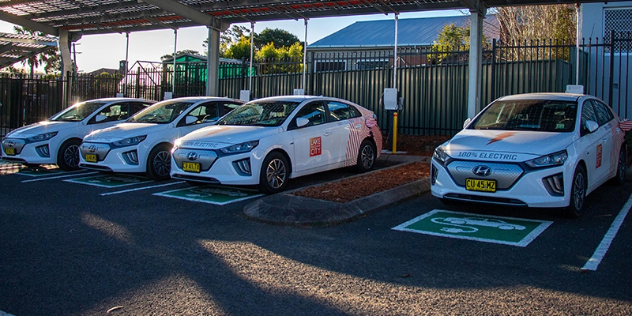Revving up for a green future in motoring

A future of electric vehicle fleets for businesses across Australia is on the cards and local governments are getting prepared for the transition. Here is what they are doing to support the move to green transport.
Many local governments have now embraced their responsibility to reduce carbon emissions by leading the way with electric vehicle (EV) infrastructure and the electrification of their fleets.
Some started by buying EVs and using them in education campaigns with residents. Others are future proofing their cities by incorporating charging stations into their development guidelines.
In 2020, the Electric Vehicle Council created a resource pack for local governments to help them develop strategies and implementation plans based on the experiences of councils that had already started the journey.
Lake Macquarie leading the way
Lake Macquarie City Council, an NRMA business member, was featured in one of the case studies after they took on the project of building a consistent vehicle charging infrastructure across their city.
The council already had a number of policies on sustainability that guided decisions on city planning. This prompted an investigation into the role that electric vehicles would play in the community, and how EV charging should be included in the planning stages of developments.
Glenn Hattander, Plant and Fleet Coordinator at Lake Macquarie Council, was involved in the project that was coordinated by Bryn Hernandez, Senior Asset Optimisation Officer. Hattander was amazed at the level of complexity involved in planning for a city to support a transport hierarchy that prioritises people and public transport.
“The council has been an early mover in electric vehicles and with the support of the Executive Management team, we purchased a first-generation Mitsubishi i-MiEV and Nissan Leaf back in 2012,” says Hattander.
According to Hattander, Lake Macquarie City Council started reducing its vehicle emissions in 2008 when the fleet transitioned from six-cylinder large sedans to smaller, four-cylinder cars. “We moved to diesels and now hybrids. The vehicle options in our fleet policy are now 80% hybrids as we continue the transition to electric vehicles.”
Hattander notes that the council’s electric vehicle charging strategy involves all employees and residents. “We need to support the community by building the infrastructure and planning for the future. It’s not just the fleet team buying some electric cars.”

Above: Lake Macquarie Council's fleet of Hyundai EVs
Triumphing over the rough terrain of transition
Transition has not been without its challenges. The power loads of older buildings and the need for community education about this topic are two such challenges. These were discussed in internal workshops with team members from multiple stakeholders across the council.
“There is also a lake in the middle of our city, which is four times the size of Sydney Harbour. This caused some range issues with the first generation of electric vehicles,” says Hattander. “The current generation of electric cars can travel up to 300km, which means they can loop the lake three times on one charge.”
Two barriers to adoption are range anxiety and lack of charging stations. People are concerned they will run out of power and get stranded on the roadside. To combat this, visibility of vehicles in the community and infrastructure is needed to quell their fears.
Lake Macquarie City Council has branded its most recent EV vehicles using brightly coloured vehicle wraps. They now have five zero-emission vehicles in the fleet with another four to be delivered in September that staff can use as pool vehicles.
More charging infrastructure will increase EV adoption by residents
The Council has also recently partnered with Origin Energy on an ARENA-funded trial to support fleet charging across NSW. Lake Macquarie City Council has two sites with a total of ten charging stations to provide charging to the nine zero-emission vehicles of the Council. These Council sites are part of a broader trial involving 150 charging stations.
The council’s Electric Vehicle Charging Strategy 2020-2023 outlines a plan to build, or encourage the building of, 11 charging stations in the community that are visible, strategically located, and accessible to the public. Some of the charging stations will be free and all will be simple to use, which will encourage residents and staff to try them.

Above: Lake Macquarie Council's fleet of Hyundai EVs
Another key objective of the plan is to encourage the use of smart energy and smart grid management. This will involve monitoring the early stages of adoption with an aim to increase renewable energy usage and Vehicle-2-Grid (V2G) opportunities and, ultimately, reduce costs and carbon emissions.
Change isn’t cheap, though. According to Hattander, the council are still in the early stages of EV adoption and there is a cost to go electric. He says the support they’ve received from their Executive Management has made it easier for all stakeholders to get involved.
“The reality is people will still need to charge at home. As a council, we need to take the lead in the community by building the infrastructure and giving our residents confidence in EV technology to reduce overall carbon emissions in our city.”
We can see that some positive steps are being taken. Some Australian states have also recently introduced new incentives for buying an EV. In NSW, you could get a discount of $3000 on EVs under $68,750 if you buy one of the first 25,000 vehicles. You could also be exempt from stamp duty for EVs up to $78,000. In ACT, if you buy a new EV, you could be exempt from stamp duty. If you buy a new or used EV before 30 June 2024, you will receive two years of free registration.
We’re en route towards a green vehicle future, so now is a good time to start thinking about what that means for your business. And keep an eye out for more business member EV experiences to get knowledge and insights about this transition.


